This document discusses various aspects of water resources and water management. It begins by defining water and providing general facts about the global water supply, including that only 3% is freshwater. It then discusses different sources of fresh water such as surface water, groundwater, frozen water, and desalination. It also covers water management, the need for water resource management, water efficiency strategies like reducing leaks and consumption, and water conservation methods for households, commercial, and agricultural use like low-flow fixtures and drip irrigation. The overall document provides a broad overview of water resources, sources, uses, and strategies for effective management and conservation of this vital resource.















































